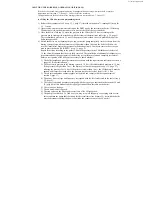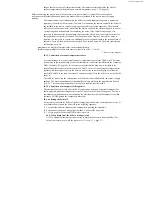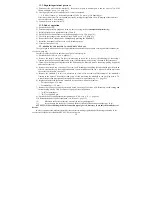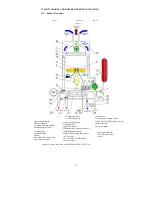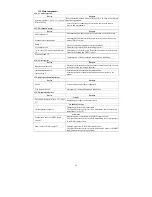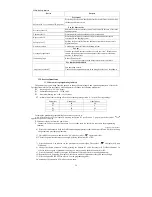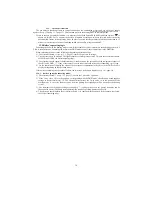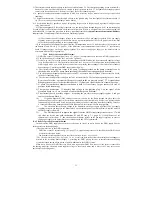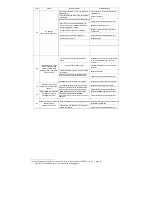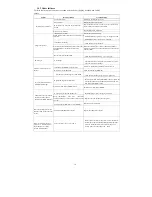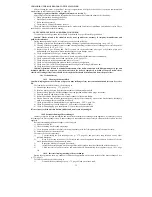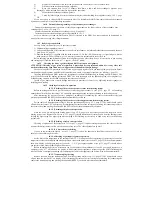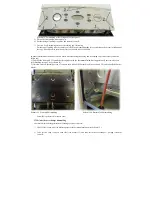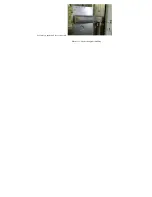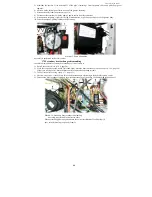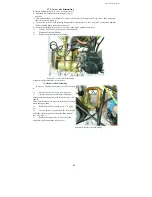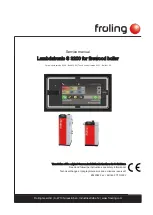
35
15. HANDING THE BOILER OVER TO THE CUSTOMER
After mounting the boiler, a specialist of the service organization is obliged to check boiler’s operation at minimal and
maximal power in all modes (see section
11, page 25).
Gas supply regulator should be obligatory adjusted
(see section
11
).
After completion of installation and adjustment works, user should be instructed about boiler’s handling:
Safety precautions when using the boiler;
Procedure of switching on/off a boiler;
Boiler operation control;
Treatment of a boiler performed by the user.
The mark about the effectuated instruction must be made in the Certificate of installation and technical service. There
should also be a mark about boiler mounting.
16.
TECHNICAL SERVICE AND OPERATION CHECK
Technical service and operation check should be performed by a special service organization.
Caution! Works related to the technical service don’t go under the warranty of company- manufacturer and
paid by the customers.
During annual technical service it is necessary to carry out the following:
1)
Cleaning of the burner block (burner) including cleaning of ignition and ionization plugs (see p.
16.1.1);
2)
Cleaning of the heat exchanger from soot and cleaning (washing) the tubes of heat exchanger from scale deposit (if
necessary) (see p 16.1.2; p 16.1.3,);
3)
Replace seals in gas, heating and DHW systems (in such connections where gas or hydraulic pipes were
disassembled or in the places where water, heat carrier or gas leakage occur);
4)
Check air-tightness of boiler’ gas, heating and DHW systems;
5)
Lubricate moving connections (if necessary), dense silicon- based lubricants are recommended;
6)
Check operation of safety devices and sensors(see p.16.2.2, page.39);
7)
Check air pressure in the expansion tank (once in 3 years);
8)
Check air inlet and combustion products outlet systems for air-tightness;
9)
Check water flow in DHW (consumption must be enough for switching DHW mode on);
10)
Check the heating system on contamination.
Caution! Operations related to technical maintenance of the boiler, connected with disassembling of its gas and
hydraulic pipelines, are necessary to perform only when the boiler is completely switched off (taps on boiler’s heat
carrier, water and gas lines inlets should be closed, the boiler should be disconnected from the power line).
16.1. Technical service
16.1.1
Cleaning the burner block
Caution! Keeping burner block clean will protect heat exchanger from soot contamination and increase its service
life.
To clean the burner block (burner) it is necessary to:
1)
dismount the burner (see p.
17.1, page 41);
2)
Remove dust by the brush from the external burner’s surfaces and manifold;
3)
Remove carbon deposit with fine sandpaper from the ignition and ionization plugs’ electrodes;
4)
Wipe the manifold and nozzles with a wet rag;
5)
Remove dust with a brush-cleaner out of inner channels of the burner blades;
6)
Wash a burner in soap solution, particularly inner cavities of its sections by means of the brush-cleaner, thoroughly
wash it in running water, dry and then put it back;
7)
Check joints subject to disassembling for air-tightness(see p.
16.2.1, page 39);
8)
Check if ignition plug is on the distance 5+ 0,5 mm above the burner blades;
9)
Check if ionization plug is on the distance 3+0,5 mm above the burner blades.
It is necessary to check whether burner’s blades and nozzles are not damaged.
16.1.2 External cleaning of heat exchanger
In order to improve full gas combustion and to achieve maximum heat exchange in the appliance, it is necessary to keep
the finning of the heat exchanger clean. If heat exchanger is contaminated, it is necessary to clean its surfaces where soot has
appeared.
Before disassembling the heat exchanger it is necessary to:
1)
Switch the boiler off;
2)
Close the heating line inlet and output taps;
3)
Cover the pump and other electrical (electronic) appliances with the film against possible heat carrier entry;
4)
Drain the heat carrier from the boiler.
To remove the soot it is necessary:
1)
To disassembly the heat exchanger (see p.
17.2, page 42) and put it into soap solution or any other
synthetic detergent;
2)
Keep it in the soap solution for 10-15 minutes and clean the upper and bottom surfaces by means of the soft
brush, then wash under strong current of water;
3)
Repeat the whole process again if necessary;
4)
Install the heat exchanger with the new gaskets, rubber gaskets should be lubricated with the silicon oil;
5)
Check the joints of gas, heat carrier and water subject to disassembling for air-tightness (see p 16.2.1, page
39).
16.1.3.
Internal cleaning (washing) of heat exchanger
During the exploitation there is a chance of scale deposit appearance on the inner surfaces of the heat exchanger 2 (see
p.
13.1, page 7).
To remove scale deposit it is necessary to:
1)
Demount the heat exchanger (see p. 17.2, page 42) and put it into a tank;
Summary of Contents for NEVALUX-8230
Page 35: ...Assembly is performed in reverse order Scheme 23 Heat exchanger dismantling...
Page 41: ...48...
Page 47: ...Ignition and ionization plugs in the assembly pos 67...
Page 54: ......
Page 55: ......

